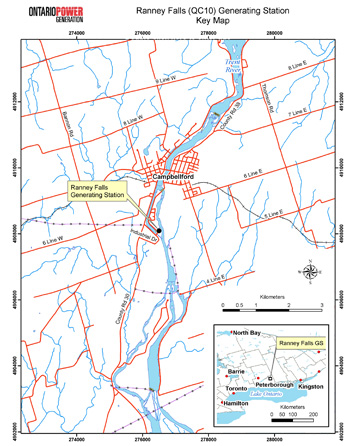
Project information
 Ontario Power Generation Inc. is proposing to expand its Ranney Falls Generating Station (GS) by replacing its G3 turbine unit which has reached its end-of-life with a new G3 unit with greater capacity. Total station capacity will be increased from approximately 10 to 20 megawatts, which is enough electricity to power about 8,000 to 10,000 homes.
Ontario Power Generation Inc. is proposing to expand its Ranney Falls Generating Station (GS) by replacing its G3 turbine unit which has reached its end-of-life with a new G3 unit with greater capacity. Total station capacity will be increased from approximately 10 to 20 megawatts, which is enough electricity to power about 8,000 to 10,000 homes.
Ranney Falls GS is located on the Trent River and adjacent to Lock #12 on the Trent-Severn Waterway (TSW) within the community of Campbellford in the Municipality of Trent Hills, Northumberland County.
The proposed Ranney Falls G3 Project is being undertaken by OPG to improve the available hydroelectric potential at the site, to reduce greenhouse gas emissions and to increase the amount of clean renewable energy available to consumers.
The proposed Project involves the following components/activities:
- expansion of the existing forebay and tailrace channels;
- construction of a new G3 powerhouse with a new intake structure and 10 MW generating unit adjacent to the existing main powerhouse;
- construction of a new electrical substation to connect with one of the Hydro One Networks Inc. local distribution lines on site;
- construction of a new spillway to by-pass full station flow to the tailrace channel for emergency situations;
- decommissioning the secondary powerhouse and end of life 0.8 MW unit; and
- rehabilitation of the stoplog structure and its operating deck (work platform) adjacent to the roadway/TSW bridge
Aerial photo of Ranney Falls GS and proposed expansion features

Schematic of proposed Ranney Falls G3 project infrastructure layout
Detailed information about the proposed Ranney Falls G3 Project can be found in the document Project Description for federal agency review found in Project Documents below.
DISCLAIMER: Please note this website was only actively maintained during the related EA process period. As this process may have closed several years ago, the content of this site may not accurately reflect the current date and may include language with incorrect time references.

